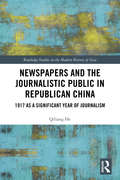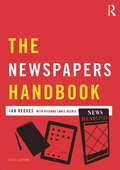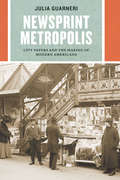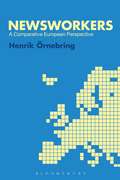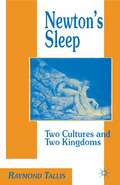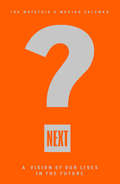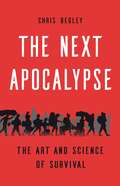- Table View
- List View
Newspaper Journalism (PDF)
by Tony Harcup Peter ColeAre newspapers faced with an existential threat or are they changing to meet the challenges of a digital world? With the newspaper's role in a state of fundamental redefinition, Newspaper Journalism offers a timely and up to the minute analysis of newspapers today, in the context of their historical importance to society. Drawing on their extensive experience in academia and also across local, national, mainstream and alternative newspapers, Cole and Harcup write clearly and engagingly from both industry and scholarly perspectives, and contend that, far from dying, newspapers are doing what they have always done: adapting to a changing environment. This text is essential reading for all students of the press, with comprehensive and critical coverage of the most important debates in the study of newspaper journalism - from ethics and investigative journalism to political economy and the future of the industry. Given the shifting boundaries and central importance of newspapers, it will be of interest to all students of journalism and the media. Praise for the Journalism Studies: Key Texts series: 'It is easy to describe a good textbook for a specific journalistic format. . . The ideal book has to satisfy a list of requirements that are also bullet-pointed in journalism assignment outlines. A text has to: synthesize the existing body of knowledge; explain concepts clearly; have a logical order of topics; and provide enough information and directions to pursue further study. One may also hope it would include real life examples and be lucid, vivid and a pleasure to read. Hard to find? Not anymore. The new SAGE series Journalism Studies: Key Texts satisfies the main requirements on the list. Carefully planned and meticulously edited by Martin Conboy, David Finkelstein and Bob Franklin, the textbook series is a welcome contribution to the literature of journalism studies. . . All three books follow the same structural template: an overview of historical development; explication of the political and economic frameworks within particular types of journalism; a review of contemporary practices; social demographics; a comparative analysis of practices around the world; a summary of main conceptual approaches; an indication of future directions; recommendations for further reading. This strong organization resembles a template for a course outline. This is intentional because the series is aimed both at students and their practice-based lecturers, who often come straight from industry and need time to adjust to the academic environment. . . [The series] achieves its aim to bridge the sometimes too evident dissonance between journalism theory and practice. . . They successfully situate discussions about journalism in social and historical contexts. We see the faces of individual journalists, the circumstances of news production, the relationship with owners, the battle between the public service and the profit nature of news, the relevance of journalism work. The detailed account of the conditions under which newspaper, radio and alternative journalism is produced and performed make the Journalism Studies: Key Texts series mandatory reading for both journalism students and their lecturers' - Verica Rupar, Journalism Studies
Newspapers and the Journalistic Public in Republican China: 1917 as a Significant Year of Journalism (Routledge Studies in the Modern History of Asia)
by Qiliang HeOffering an entirely new approach to understanding China’s journalism history, this book covers the Chinese periodical press in the first half of the twentieth century. By focusing on five cases, either occurring in or in relation to the year 1917, this book emphasizes the protean nature of the newspaper and seeks to challenge a press historiography which suggests modern Chinese newspapers were produced and consumed with clear agendas of popularizing enlightenment, modernist, and revolutionary concepts. Instead, this book contends that such a historiography, which is premised on the classification of newspapers along the lines of their functions, overlooks the opaqueness of the Chinese press in the early twentieth century. Analyzing modern Chinese history through the lens of the newspaper, this book presents an interdisciplinary and international approach to studying mass communications. As such, this book will be useful to students and scholars of Chinese history, journalism, and Asian Studies more generally.
Newspapers and the Journalistic Public in Republican China: 1917 as a Significant Year of Journalism (Routledge Studies in the Modern History of Asia)
by Qiliang HeOffering an entirely new approach to understanding China’s journalism history, this book covers the Chinese periodical press in the first half of the twentieth century. By focusing on five cases, either occurring in or in relation to the year 1917, this book emphasizes the protean nature of the newspaper and seeks to challenge a press historiography which suggests modern Chinese newspapers were produced and consumed with clear agendas of popularizing enlightenment, modernist, and revolutionary concepts. Instead, this book contends that such a historiography, which is premised on the classification of newspapers along the lines of their functions, overlooks the opaqueness of the Chinese press in the early twentieth century. Analyzing modern Chinese history through the lens of the newspaper, this book presents an interdisciplinary and international approach to studying mass communications. As such, this book will be useful to students and scholars of Chinese history, journalism, and Asian Studies more generally.
The Newspapers Handbook
by Richard Keeble Ian ReevesThis new edition of The Newspapers Handbook presents an enlightening examination of an ever-evolving industry, engaging with key contemporary issues, including reporting in the digital age and ethical and legislative issues following the hacking scandal to display a comprehensive anatomy of the modern newsroom. Richard Lance Keeble and Ian Reeves offer readers expert practical advice, drawing on a wide range of examples from print and digital news sources to illustrate best practice and the political, technological and financial realities of newspaper journalism today. Other key areas explored include: the language of news basic reporting the art of interviewing feature writing the role of social media in reporting investigative reporting court reporting reporting on national and local government guidance on training and careers for those entering the industry.
The Newspapers Handbook
by Richard Keeble Ian ReevesThis new edition of The Newspapers Handbook presents an enlightening examination of an ever-evolving industry, engaging with key contemporary issues, including reporting in the digital age and ethical and legislative issues following the hacking scandal to display a comprehensive anatomy of the modern newsroom. Richard Lance Keeble and Ian Reeves offer readers expert practical advice, drawing on a wide range of examples from print and digital news sources to illustrate best practice and the political, technological and financial realities of newspaper journalism today. Other key areas explored include: the language of news basic reporting the art of interviewing feature writing the role of social media in reporting investigative reporting court reporting reporting on national and local government guidance on training and careers for those entering the industry.
NEWSPEAK in the 21st Century
by David Edwards David CromwellMedia Lens' mission is to correct the distorted vision of the liberal media. A thorn in the side of the Guardian, Independent, Channel 4 and the BBC, among many others, it is constantly under counterfire by those it attacks.*BR**BR*These responses are collected in Newspeak. They expose the arrogance and servility to power of our leading journalists and editors, starring Andrew Marr, Alan Rusbridger, Roger Alton, Jon Snow, Jeremy Bowen and even George Monbiot.*BR**BR*Packed with forensic media analysis, revealing the lethal bias in 'balanced' reporting. Even the 'best' UK media turn out to be cheerleaders for government, business and war. *BR**BR*Alongside an A-Z of BBC propaganda and chapters on Iraq and climate change, Newspeak focuses on the demonisation of Iran and Venezuela, the Israel-Palestine conflict, the myth of impartial reporting and the dark art of smearing dissidents.
NEWSPEAK in the 21st Century
by David Edwards David CromwellMedia Lens' mission is to correct the distorted vision of the liberal media. A thorn in the side of the Guardian, Independent, Channel 4 and the BBC, among many others, it is constantly under counterfire by those it attacks.*BR**BR*These responses are collected in Newspeak. They expose the arrogance and servility to power of our leading journalists and editors, starring Andrew Marr, Alan Rusbridger, Roger Alton, Jon Snow, Jeremy Bowen and even George Monbiot.*BR**BR*Packed with forensic media analysis, revealing the lethal bias in 'balanced' reporting. Even the 'best' UK media turn out to be cheerleaders for government, business and war. *BR**BR*Alongside an A-Z of BBC propaganda and chapters on Iraq and climate change, Newspeak focuses on the demonisation of Iran and Venezuela, the Israel-Palestine conflict, the myth of impartial reporting and the dark art of smearing dissidents.
Newsprint Metropolis: City Papers and the Making of Modern Americans (Historical Studies of Urban America)
by Julia GuarneriAt the turn of the twentieth century, ambitious publishers like Joseph Pulitzer, William Randolph Hearst, and Robert McCormick produced the most spectacular newspapers Americans had ever read. Alongside current events and classified ads, publishers began running comic strips, sports sections, women’s pages, and Sunday magazines. Newspapers’ lavish illustrations, colorful dialogue, and sensational stories seemed to reproduce city life on the page. Yet as Julia Guarneri reveals, newspapers did not simply report on cities; they also helped to build them. Metropolitan sections and civic campaigns crafted cohesive identities for sprawling metropolises. Real estate sections boosted the suburbs, expanding metropolitan areas while maintaining cities’ roles as economic and information hubs. Advice columns and advertisements helped assimilate migrants and immigrants to a class-conscious, consumerist, and cosmopolitan urban culture. Newsprint Metropolis offers a tour of American newspapers in their most creative and vital decades. It traces newspapers’ evolution into highly commercial, mass-produced media, and assesses what was gained and lost as national syndicates began providing more of Americans’ news. Case studies of Philadelphia, New York, Chicago, and Milwaukee illuminate the intertwined histories of newspapers and the cities they served. In an era when the American press is under attack, Newsprint Metropolis reminds us how papers once hosted public conversations and nurtured collective identities in cities across America.
Newsprint Metropolis: City Papers and the Making of Modern Americans (Historical Studies of Urban America)
by Julia GuarneriAt the turn of the twentieth century, ambitious publishers like Joseph Pulitzer, William Randolph Hearst, and Robert McCormick produced the most spectacular newspapers Americans had ever read. Alongside current events and classified ads, publishers began running comic strips, sports sections, women’s pages, and Sunday magazines. Newspapers’ lavish illustrations, colorful dialogue, and sensational stories seemed to reproduce city life on the page. Yet as Julia Guarneri reveals, newspapers did not simply report on cities; they also helped to build them. Metropolitan sections and civic campaigns crafted cohesive identities for sprawling metropolises. Real estate sections boosted the suburbs, expanding metropolitan areas while maintaining cities’ roles as economic and information hubs. Advice columns and advertisements helped assimilate migrants and immigrants to a class-conscious, consumerist, and cosmopolitan urban culture. Newsprint Metropolis offers a tour of American newspapers in their most creative and vital decades. It traces newspapers’ evolution into highly commercial, mass-produced media, and assesses what was gained and lost as national syndicates began providing more of Americans’ news. Case studies of Philadelphia, New York, Chicago, and Milwaukee illuminate the intertwined histories of newspapers and the cities they served. In an era when the American press is under attack, Newsprint Metropolis reminds us how papers once hosted public conversations and nurtured collective identities in cities across America.
Newsprint Metropolis: City Papers and the Making of Modern Americans (Historical Studies of Urban America)
by Julia GuarneriAt the turn of the twentieth century, ambitious publishers like Joseph Pulitzer, William Randolph Hearst, and Robert McCormick produced the most spectacular newspapers Americans had ever read. Alongside current events and classified ads, publishers began running comic strips, sports sections, women’s pages, and Sunday magazines. Newspapers’ lavish illustrations, colorful dialogue, and sensational stories seemed to reproduce city life on the page. Yet as Julia Guarneri reveals, newspapers did not simply report on cities; they also helped to build them. Metropolitan sections and civic campaigns crafted cohesive identities for sprawling metropolises. Real estate sections boosted the suburbs, expanding metropolitan areas while maintaining cities’ roles as economic and information hubs. Advice columns and advertisements helped assimilate migrants and immigrants to a class-conscious, consumerist, and cosmopolitan urban culture. Newsprint Metropolis offers a tour of American newspapers in their most creative and vital decades. It traces newspapers’ evolution into highly commercial, mass-produced media, and assesses what was gained and lost as national syndicates began providing more of Americans’ news. Case studies of Philadelphia, New York, Chicago, and Milwaukee illuminate the intertwined histories of newspapers and the cities they served. In an era when the American press is under attack, Newsprint Metropolis reminds us how papers once hosted public conversations and nurtured collective identities in cities across America.
Newsprint Metropolis: City Papers and the Making of Modern Americans (Historical Studies of Urban America)
by Julia GuarneriAt the turn of the twentieth century, ambitious publishers like Joseph Pulitzer, William Randolph Hearst, and Robert McCormick produced the most spectacular newspapers Americans had ever read. Alongside current events and classified ads, publishers began running comic strips, sports sections, women’s pages, and Sunday magazines. Newspapers’ lavish illustrations, colorful dialogue, and sensational stories seemed to reproduce city life on the page. Yet as Julia Guarneri reveals, newspapers did not simply report on cities; they also helped to build them. Metropolitan sections and civic campaigns crafted cohesive identities for sprawling metropolises. Real estate sections boosted the suburbs, expanding metropolitan areas while maintaining cities’ roles as economic and information hubs. Advice columns and advertisements helped assimilate migrants and immigrants to a class-conscious, consumerist, and cosmopolitan urban culture. Newsprint Metropolis offers a tour of American newspapers in their most creative and vital decades. It traces newspapers’ evolution into highly commercial, mass-produced media, and assesses what was gained and lost as national syndicates began providing more of Americans’ news. Case studies of Philadelphia, New York, Chicago, and Milwaukee illuminate the intertwined histories of newspapers and the cities they served. In an era when the American press is under attack, Newsprint Metropolis reminds us how papers once hosted public conversations and nurtured collective identities in cities across America.
Newsprint Metropolis: City Papers and the Making of Modern Americans (Historical Studies of Urban America)
by Julia GuarneriAt the turn of the twentieth century, ambitious publishers like Joseph Pulitzer, William Randolph Hearst, and Robert McCormick produced the most spectacular newspapers Americans had ever read. Alongside current events and classified ads, publishers began running comic strips, sports sections, women’s pages, and Sunday magazines. Newspapers’ lavish illustrations, colorful dialogue, and sensational stories seemed to reproduce city life on the page. Yet as Julia Guarneri reveals, newspapers did not simply report on cities; they also helped to build them. Metropolitan sections and civic campaigns crafted cohesive identities for sprawling metropolises. Real estate sections boosted the suburbs, expanding metropolitan areas while maintaining cities’ roles as economic and information hubs. Advice columns and advertisements helped assimilate migrants and immigrants to a class-conscious, consumerist, and cosmopolitan urban culture. Newsprint Metropolis offers a tour of American newspapers in their most creative and vital decades. It traces newspapers’ evolution into highly commercial, mass-produced media, and assesses what was gained and lost as national syndicates began providing more of Americans’ news. Case studies of Philadelphia, New York, Chicago, and Milwaukee illuminate the intertwined histories of newspapers and the cities they served. In an era when the American press is under attack, Newsprint Metropolis reminds us how papers once hosted public conversations and nurtured collective identities in cities across America.
Newsprint Metropolis: City Papers and the Making of Modern Americans (Historical Studies of Urban America)
by Julia GuarneriAt the turn of the twentieth century, ambitious publishers like Joseph Pulitzer, William Randolph Hearst, and Robert McCormick produced the most spectacular newspapers Americans had ever read. Alongside current events and classified ads, publishers began running comic strips, sports sections, women’s pages, and Sunday magazines. Newspapers’ lavish illustrations, colorful dialogue, and sensational stories seemed to reproduce city life on the page. Yet as Julia Guarneri reveals, newspapers did not simply report on cities; they also helped to build them. Metropolitan sections and civic campaigns crafted cohesive identities for sprawling metropolises. Real estate sections boosted the suburbs, expanding metropolitan areas while maintaining cities’ roles as economic and information hubs. Advice columns and advertisements helped assimilate migrants and immigrants to a class-conscious, consumerist, and cosmopolitan urban culture. Newsprint Metropolis offers a tour of American newspapers in their most creative and vital decades. It traces newspapers’ evolution into highly commercial, mass-produced media, and assesses what was gained and lost as national syndicates began providing more of Americans’ news. Case studies of Philadelphia, New York, Chicago, and Milwaukee illuminate the intertwined histories of newspapers and the cities they served. In an era when the American press is under attack, Newsprint Metropolis reminds us how papers once hosted public conversations and nurtured collective identities in cities across America.
Newsrooms and the Disruption of the Internet: A Short History of Disruptive Technologies, 1990–2010 (Disruptions)
by Will MariNewsrooms and the Disruption of the Internet is an insightful account of what happened when the internet first arrived in the 1990s and early 2000s in the recently computerized, but still largely unchanged, newspaper industry. Providing a focused narrative of how the internet disrupted news collection, editing, presentation and dissemination, the book examines the role of the internet from helpful adjunct to extension to, eventually, successor to the traditional print product. Experiments by large national newspaper “brands” and other first-adopters in the 1990s are described, tracing the slow adoption of the internet by chains and large metro papers, followed by the smaller daily and weekly newspapers by the early 2000s. The book describes the changes that arrived as more “Web 2.0” technologies become prevalent and as social media shifted the news-media landscape in the mid-to-late 2000s, ultimately changing how most people in the West consumed and thought of “the news”. This book is intended for academics and researchers in the fields of journalism studies, history of technology, and media studies, especially those interested in transitions from analogue to digital technology, and the initial adoption of the commercial internet.
Newsrooms and the Disruption of the Internet: A Short History of Disruptive Technologies, 1990–2010 (Disruptions)
by Will MariNewsrooms and the Disruption of the Internet is an insightful account of what happened when the internet first arrived in the 1990s and early 2000s in the recently computerized, but still largely unchanged, newspaper industry. Providing a focused narrative of how the internet disrupted news collection, editing, presentation and dissemination, the book examines the role of the internet from helpful adjunct to extension to, eventually, successor to the traditional print product. Experiments by large national newspaper “brands” and other first-adopters in the 1990s are described, tracing the slow adoption of the internet by chains and large metro papers, followed by the smaller daily and weekly newspapers by the early 2000s. The book describes the changes that arrived as more “Web 2.0” technologies become prevalent and as social media shifted the news-media landscape in the mid-to-late 2000s, ultimately changing how most people in the West consumed and thought of “the news”. This book is intended for academics and researchers in the fields of journalism studies, history of technology, and media studies, especially those interested in transitions from analogue to digital technology, and the initial adoption of the commercial internet.
Newsworkers: A Comparative European Perspective
by Henrik ÖrnebringThe last decade has seen a transformation of journalism industries and the working lives of our journalists. Do the changes have the same impact everywhere? Do journalists today experience these changes as a pressure or as a possibility? Is something irrevocably lost from journalism with these changes? Newsworkers takes a broad range of European countries - North and South, East and West, big and small - comparing in each how journalism as work has been affected by the changes in journalism institutions. The book looks at three pertinent and topical questions: the role of technology in changing journalism work practice; the decline or not of professional values; and whether journalism is becoming more homogenous across national borders. Drawing on extensive and original research, the book provides a comprehensive picture of contemporary European journalism.
Newsworkers: A Comparative European Perspective
by Henrik ÖrnebringThe last decade has seen a transformation of journalism industries and the working lives of our journalists. Do the changes have the same impact everywhere? Do journalists today experience these changes as a pressure or as a possibility? Is something irrevocably lost from journalism with these changes? Newsworkers takes a broad range of European countries - North and South, East and West, big and small - comparing in each how journalism as work has been affected by the changes in journalism institutions. The book looks at three pertinent and topical questions: the role of technology in changing journalism work practice; the decline or not of professional values; and whether journalism is becoming more homogenous across national borders. Drawing on extensive and original research, the book provides a comprehensive picture of contemporary European journalism.
Newton's Sleep: The Two Cultures and the Two Kingdoms
by R. Tallis'Vast in its intellectual scope, it should induce not so much sleep as controversy, whether literary or scientific, philosophical or political. It skims the oceans of academe in a manner accessible to the educated public, informed and cogently argued, stylistically dense...' - Sandra Goldbeck-Wood, British Medical Journal `Tallis can, and frequently does, write extremely well. He also writes with considerable passion...Raymond Tallis, is perhaps best seen as an exceptionally interesting and broad-minded heir to Huxley, preaching the cause of the Church Scientific.' - Richard Webster, Times Literary Supplement Reviews of Not Saussure and The Explicit Animal: Not Saussure - 'I greatly enjoyed it...' - Bernard Bergonzi 'The Explicit Animal - '...his books are genuine contributions to professional debate...' - Stephen R.L. Clarke, Times Literary Supplement Newton's Sleep examines the complementary roles of science and art in human life. Science has been criticised for being at best useful but spiritually derelict, and art for attempting to answer the spiritual needs of humankind while ignoring the material needs of millions who live in want. Newton's Sleep deals with the charges that science is spiritually empty and that art fails in its civilising mission by relating these aspects of human culture to the physical and metaphysical hungers of an explicit animal who lives in both the Kingdom of Means and the Kingdom of Ends. 'Tallis can, and frequently does, write extremely well. He also writes with considerable passion...Tallis...is perhaps best seen as an exceptionally interesting and broad-minded heir to Huxley, preaching the cause of the Church Scientific...' Richard Webster
Next: A Vision Of Our Lives In The Future
by Marian Salzman Ira MatathiaAn almanac of the future for anyone who wants to know what’s new and exciting and around the corner…
The Next America: Boomers, Millennials, and the Looming Generational Showdown
by Paul Taylor Pew Research CenterThe America of the near future will look nothing like the America of the recent past.America is in the throes of a demographic overhaul. Huge generation gaps have opened up in our political and social values, our economic well-being, our family structure, our racial and ethnic identity, our gender norms, our religious affiliation, and our technology use.Today's Millennials-well-educated, tech savvy, underemployed twenty-somethings-are at risk of becoming the first generation in American history to have a lower standard of living than their parents. Meantime, more than 10,000 Baby Boomers are retiring every single day, most of them not as well prepared financially as they'd hoped. This graying of our population has helped polarize our politics, put stresses on our social safety net, and presented our elected leaders with a daunting challenge: How to keep faith with the old without bankrupting the young and starving the future.Every aspect of our demography is being fundamentally transformed. By mid-century, the population of the United States will be majority non-white and our median age will edge above 40-both unprecedented milestones. But other rapidly-aging economic powers like China, Germany, and Japan will have populations that are much older. With our heavy immigration flows, the US is poised to remain relatively young. If we can get our spending priorities and generational equities in order, we can keep our economy second to none. But doing so means we have to rebalance the social compact that binds young and old. In tomorrow's world, yesterday's math will not add up.Drawing on Pew Research Center's extensive archive of public opinion surveys and demographic data, The Next America is a rich portrait of where we are as a nation and where we're headed-toward a future marked by the most striking social, racial, and economic shifts the country has seen in a century.
The Next America: Boomers, Millennials, and the Looming Generational Showdown
by Paul Taylor Pew Research CenterThe America of the near future will look nothing like the America of the recent past. America is in the throes of a demographic overhaul. Huge generation gaps have opened up in our political and social values, our economic well-being, our family structure, our racial and ethnic identity, our gender norms, our religious affiliation, and our technology use. Today's Millennials -- well-educated, tech savvy, underemployed twenty-somethings -- are at risk of becoming the first generation in American history to have a lower standard of living than their parents. Meantime, more than 10,000 Baby Boomers are retiring every single day, most of them not as well prepared financially as they'd hoped. This graying of our population has helped polarize our politics, put stresses on our social safety net, and presented our elected leaders with a daunting challenge: How to keep faith with the old without bankrupting the young and starving the future. Every aspect of our demography is being fundamentally transformed. By mid-century, the population of the United States will be majority non-white and our median age will edge above 40 -- both unprecedented milestones. But other rapidly-aging economic powers like China, Germany, and Japan will have populations that are much older. With our heavy immigration flows, the US is poised to remain relatively young. If we can get our spending priorities and generational equities in order, we can keep our economy second to none. But doing so means we have to rebalance the social compact that binds young and old. In tomorrow's world, yesterday's math will not add up. Drawing on Pew Research Center's extensive archive of public opinion surveys and demographic data, The Next America is a rich portrait of where we are as a nation and where we're headed -- toward a future marked by the most striking social, racial, and economic shifts the country has seen in a century.
The Next Apocalypse: The Art and Science of Survival
by Chris BegleyIn this insightful book, an underwater archaeologist and survival coach shows how understanding the collapse of civilizations can help us prepare for a troubled future.Pandemic, climate change, or war: our era is ripe with the odor of doomsday. In movies, books, and more, our imaginations run wild with visions of dreadful, abandoned cities and returning to the land in a desperate attempt at survival.In The Next Apocalypse, archaeologist Chris Begley argues that we completely misunderstand how disaster works. Examining past collapses of civilizations, such as the Maya and Rome, he argues that these breakdowns are actually less about cataclysmic destruction than they are about long processes of change. In short: it&’s what happens after the initial uproar that matters. Some people abandon their homes and neighbors; others band together to start anew. As we anticipate our own fate, Begley tells us that it was communities, not lone heroes, who survived past apocalypses—and who will survive the next.Fusing archaeology, survivalism, and social criticism, The Next Apocalypse is an essential read for anxious times.
The Next Arab Decade: Alternative Futures
by Hisham SharabiThis book is concerned with defining the nature of the crisis of the Arab world, with tracing its possible development, and with charting the conditions of its possible outcomes, addressing the next decade from the vantage of 1986 rather than that of 1985.
The Next Arab Decade: Alternative Futures
by Hisham SharabiThis book is concerned with defining the nature of the crisis of the Arab world, with tracing its possible development, and with charting the conditions of its possible outcomes, addressing the next decade from the vantage of 1986 rather than that of 1985.
The Next Billion Users: Digital Life Beyond the West
by Payal AroraWhy do citizens of states with strict surveillance care so little about their digital privacy? Why do Brazilians eschew geo-tagging on social media? What drives young Indians to friend “foreign” strangers on Facebook and give “missed calls” to people? Payal Arora answers these questions and many more about the internet’s next billion users.

